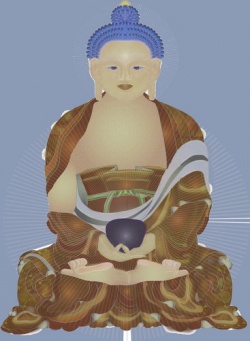Dakini World
What we are planning to discuss here is the Buddhist approach to basic principles in feminine reality. So this particular talk, I would like to point out quite boldly and specifically, is not a politics or sociology course, but is connected with the practice of meditation and phenomenal reality, and the feminine aspects as well as the masculine aspects connected with that. We could approach the basic question from the beginning, in terms of the categories or principles known in the Buddhist tradition as the three jewels: the buddha, or teacher; the dharma, or the teachings; and the sangha, or group of followers, students. We are starting from the question of whether the chicken is first or the egg the first – that is to say, whether the Buddha is first or dharma is first, in this particular case…
This question of whether buddha is first or dharma is first is a very interesting one. If there were no buddha, it would not be possible to have dharma; but in order for there to be a buddha, there would have to be dharma. A lot of teachers in the past have spent their lifetimes studying which comes first- as much as people spend time trying to figure out which came first, the egg or the chicken. It seems that both are related to the feminine principle. If there is an egg, then the feminine principle had to be involved; even if there is a chicken, the feminine principle had to be involved. That same principle implies that the originator of dharma, the originator of buddha, had to come first. At this level, we are talking about the question of the mother principle, the level of totality and background.
In the Buddhist tradition somehow—as a result of peoples’ experience, their research work, so to speak, and from the example of the Buddha’s life – it is quite clear that the dharma came first: the dharma of reality. That is to say, pain and pleasure, the conflicts of life, the idea of falsity and the idea of truth. Following the principle of the four noble truths, Buddha’s first reaction to the world was the discovery that there is unspeakable, unnameable, fundamental pain, which produces the reality of the confused realm. Because of that, he also realized that there is a realm of nonexistence – no ego, no basic being, no substance.
But at the same time, there had to [be] some intelligent mind to experience that realm. That intelligence is called prajna. Consequently, prajna is referred to as the mother of all the buddhas.
So as far as basic reality is concerned there is nothing but space, unconditional space, space that is not defined or labeled as product or producer. That is the mother of all the buddhas.
That space is called, in the traditional terminology, dharmadhatu: ‘dharma’ meaning, in this case, ‘basic norm,’ and ‘dhatu’ meaning ‘atmosphere.’ Such a basic norm is created by this atmosphere. Not ‘created,’ that is a wrong term, but it actually exists like that. There is a basic atmosphere of openness and all-pervasiveness involved, so in this case we cannot talk about the mother principle as being one or many, but in some sense, the mother principle came first.
Prajnaparamita is actually ‘not’ the name of the mother principle. The word ‘prajnaparamita’ means ‘transcendental knowledge.’ The mother of all the buddhas is in some sense an incorrect term, in fact. When we talk about the mother of all the buddhas, we are talking in terms of its function: somebody produced a child, therefore she should be called ‘mother.’ That is still a conditional definition.
If we look back, we cannot even call it mother. We cannot even define this particular relative norm as a masculine or feminine principle – we can only talk in terms of the basic atmosphere.
The only way or reason we can refer to it as feminine principle is that it has the sense of accommodation and the potentiality of giving birth. Prajnaparamita, transcendental knowledge, is an ‘expression’ of that feminine principle, called ‘mother.’ Mother is one of its attributes.’
—Chogyam Trungpa

